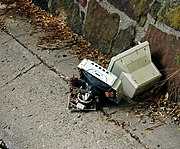

The direct disposal of electrical equipment ¡X such as old computers and mobile phones ¡X is banned in many areas due to the toxic contents of certain components. The recycling process works by mechanically separating the metals, plastics and circuit boards contained in the appliance. When this is done on a large scale at an electronic waste recycling plant, component recovery can be achieved in a cost-effective manner.
Electronic devices, including audio-visual components (televisions, VCRs, stereo equipment), mobile phones and other hand-held devices, and computer components, contain valuable elements and substances suitable for reclamation, including lead, copper, and gold. They also contain a plethora of toxic substances, such as dioxins, Polychlorinated biphenyls|PCBs, cadmium, chromium, radioactive isotopes, and mercury. Additionally, the processing required to reclaim the precious substances (including incineration and acid treatments) release, generate and synthesize further toxic by-products.
In the United States, an estimated 70% of heavy metals in landfills come from discarded electronics. Some regional governments are attempting to curtail the accumulation of electronics in landfills by passing laws obligating manufacturers and consumers to recycle these devices, but because in many cases safe dismantlement of these devices in accordance with first world safety standards is unprofitable,[citation needed] historically much of the electronic waste has been shipped to countries with lower or less rigorously-enforced safety protocols. Places like Guiyu, China dismantle tons of electronics every year, profiting from the sale of precious metals, but at the cost of the local environment and the health of its residents.
Mining to produce the same metals, to meet demand for finished products in the west, also occurs in the same countries, and the United Nations Conference on Trade and Development (UNCTAD) has recommended that restrictions against recycling exports be balanced against the environmental costs of recovering those materials from mining. Hard rock mining in the USA produces 45% of all toxics produced by all USA industries (2001 US EPA Toxics Release Inventory).